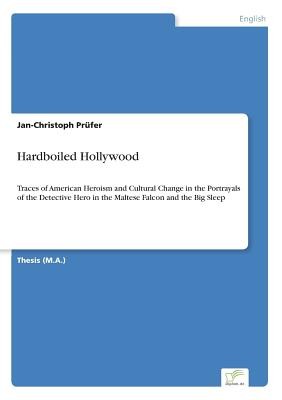
- We will send in 10–14 business days.
- Author: Jan-Christoph Prüfer
- Publisher: Diplom.de
- Year: 2007
- Pages: 102
- ISBN-10: 3836602717
- ISBN-13: 9783836602716
- Format: 14.8 x 21 x 0.6 cm, softcover
- Language: English
- SAVE -10% with code: EXTRA
Reviews
Description
Inhaltsangabe: Abstract: I have chosen the two films that will be subjected to examination in this work because they have a lot in common at first glance. Their scripts are based on crime novels of the so called hardboiled school," a stream in American popular literature that developed after the First World War. They were both filmed in the 1940s and produced by the Warner Brothers studio. No scholarly or critical discussion of the Hollywood genre of film noir is complete without them, and they both feature Humphrey Bogart as the main actor in the role of the private eye. What I hope to show this thesis is not only that these films, despite the similarities outlined above, are far from being basically the same movies, but additionally to give convincing reasons why this is the case. One of these reasons will be the evaluation of the fact that the literary private eyes that the heroes of John Huston's The Maltese Falcon (1941) and Howard Hawks' The Big Sleep (1946) are based on already differ in their character concept, and that these differences correspondingly found their way to the screen in the adaptations. A further decisive point for measuring the differences between the films is that I will assume that these movies were financial successes because they reflected the times that they were made in and thus gave movie audiences what they wanted to see. That movies are products of their time is a fact as blatant as it is true, yet one that has repeatedly been called into question in the past. The Hollywood genre system, the directors, the financial interests of the movie-making industry have all been pointed out as shaping a movie and its content rather than some mysterious connection between a film and the popular mind, the convictions, dreams and anxieties of the masses commonly referred to as a people's culture. But although I do not doubt the significance of the factors mentioned above, I agree with Albert Quart and Leonard Auster who pointed out that fil
EXTRA 10 % discount with code: EXTRA
The promotion ends in 18d.14:20:47
The discount code is valid when purchasing from 10 €. Discounts do not stack.
- Author: Jan-Christoph Prüfer
- Publisher: Diplom.de
- Year: 2007
- Pages: 102
- ISBN-10: 3836602717
- ISBN-13: 9783836602716
- Format: 14.8 x 21 x 0.6 cm, softcover
- Language: English English
Inhaltsangabe: Abstract: I have chosen the two films that will be subjected to examination in this work because they have a lot in common at first glance. Their scripts are based on crime novels of the so called hardboiled school," a stream in American popular literature that developed after the First World War. They were both filmed in the 1940s and produced by the Warner Brothers studio. No scholarly or critical discussion of the Hollywood genre of film noir is complete without them, and they both feature Humphrey Bogart as the main actor in the role of the private eye. What I hope to show this thesis is not only that these films, despite the similarities outlined above, are far from being basically the same movies, but additionally to give convincing reasons why this is the case. One of these reasons will be the evaluation of the fact that the literary private eyes that the heroes of John Huston's The Maltese Falcon (1941) and Howard Hawks' The Big Sleep (1946) are based on already differ in their character concept, and that these differences correspondingly found their way to the screen in the adaptations. A further decisive point for measuring the differences between the films is that I will assume that these movies were financial successes because they reflected the times that they were made in and thus gave movie audiences what they wanted to see. That movies are products of their time is a fact as blatant as it is true, yet one that has repeatedly been called into question in the past. The Hollywood genre system, the directors, the financial interests of the movie-making industry have all been pointed out as shaping a movie and its content rather than some mysterious connection between a film and the popular mind, the convictions, dreams and anxieties of the masses commonly referred to as a people's culture. But although I do not doubt the significance of the factors mentioned above, I agree with Albert Quart and Leonard Auster who pointed out that fil


Reviews